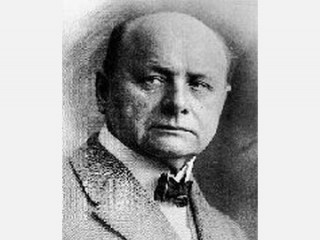
Alexej Von Jawlensky biography
Date of birth : 1864-03-13
Date of death : 1941-03-15
Birthplace : Torschok, Russia
Nationality : Russian
Category : Arts and Entertainment
Last modified : 2010-11-19
Credited as : Painter, contributor to Expressionism,
The Russian painter Alexej von Jawlensky was one of the important contributors to Expressionism, to which he added a meditative, or inward reflective, component of unique power.
Born March 13, 1864 (old calendar), on the noble family's estate near Torschok in Russia, Jawlensky was the son of a colonel and was himself destined to become an officer. While still attending cadet school he discovered the arts, and by obtaining a transfer as a young lieutenant to St. Petersburg, he was able to study at the Academy of Fine Arts and under the important Russian realist painter Ilya Repin (called the Russian Courbet). There he met the painter Marianna von Werefkin, the daughter of a general, who was to devote a large part of her life to encouraging and furthering Jawlensky's career as an artist. In 1896, by then a captain, he left the service and moved with Werefkin and Helen Nesnakomoff (her servant and later Jawlensky's wife and mother of his son Andrej) as well as two other painter friends to Munich to attend the private art school of Anton Azbé. Here he met and began a lifelong friendship with Wassily Kandinsky, who was to become one of the founders of abstract (non-objective) painting.
Extended travels in Europe and especially through France introduced Jawlensky to modern art developments. He met Henri Matisse (in 1907 he worked for a while in Matisse's studio), the symbolist painters Paul Sérusier and Jan Verkade (later to become monk Willibrord in the artistically important monastery of Beuron), as well as the Fauvist Kees van Dongen, among others. After his return to Munich he met Paul Klee and Franz Marc and joined them and Kandinsky in the most avant-garde artist group in southern Germany, the Neue Kunstler Vereinigung Munchen (New Artist Association Munich). Kandinsky's long time friend Gabriele Munter, Alfred Kubin, Adolf Erbslqh, the Russian Bechtjeleff, and others belonged to his circle, in which Werefkin played an important intellectual role.
With the beginning of World War I, Jawlensky as a Russian had to leave Germany, settling in Switzerland. In 1916 he met Emmy (whom he called Galka) Scheyer, who became his student and shortly thereafter his impresario, organizing exhibitions of his works in Germany. In 1924 she formed the "Blue Four" consisting of Jawlensky, Kandinsky, Klee, and Lyonel Feininger to introduce the works of these artists to the United States; she organized—primarily in California—a number of exhibits, gave lectures, and represented the artists until her death in 1945. In 1921 Jawlensky had moved to Wiesbaden in Germany and, his friendship with Werefkin broken, had married Helen Nesnakomoff in 1922. In 1929 he began to suffer from arthritis which forced him to paint with both hands since he could no longer hold a brush; he was unable to paint at all after 1937. His art was declared "degenerate" by the Nazis in 1937 and 72 of his works were confiscated from collections of German museums. Jawlensky died on March 15, 1941.
Jawlensky's life work contained only three themes: still lifes, landscapes, and portraits. Convinced that the visual representation of inner experiences is the goal of the arts, he consistently sought a synthesis between the external world and the experience of the inner world of the artist. Painting in strong colors, he abbreviated the natural forms until his landscapes became colorful visions and his still lifes manifestations of serene spaces. During his time in Switzerland he painted a series of abstracted landscapes which he called "Songs without words," indicating that not an objective reproduction of natural vision but an invocation of feelings created by the natural settings was intended. Having studied the works of van Gogh and Matisse, Gauguin and Cezanne and familiar with the works of the symbolist painters as well as with Cubism and Fauvism, Jawlensky created his own forms, which were strong-colored expressions of his emotions and of his spiritual strivings and convictions.
Today he is primarily famous for the large number of portraits, which by 1916 were reduced to heads and which after 1918 became abstractions of faces. In the last form a harmonious U-form on the lower part provides the base while mouth, eyes, and forehead furnish a horizontal structure and the nose divides as a vertical the face into a lighter and a darker side. The eyebrows provide a gentle bow, and the face appears to look inwards with closed eyes. In the last works, often called "Meditations," nose, eyes, mouth, and forehead form a Greek cross with one small speck of light centered on the forehead, reminding the viewer of the sign of wisdom found on Byzantine and Russian icons of the Virgin Mary. Although consistently counted among the Expressionists, Jawlensky is the only artist to have created a meditative art: this was his unique contribution to modern art.
Two portfolios of lithographs were published: in 1919 a portfolio of eight lithographs of nudes and in 1922 a portfolio of heads. Clemens Weiler's monograph containing the oeuvre catalogue (Cologne, 1959) and his assessment Heads/Faces/Meditations (in English, 1970) are the most comprehensive studies. Weiler's 1970 work contains Jawlensky's memoirs as dictated to Lisa Kummel. Mela Escherich (Wiesbaden, 1934), Ewald Rathke (Hanau, 1968), and Jurgen Schulze (Cologne, 1970) are important monographs. There are three important studies of Marianna von Werefkin: Clemens Weiler edited the "Letters to an Unknown, 1890-1905," which she wrote in the earlier times of her relationship with Jawlensky; Jelena Hahl-Koch wrote her dissertation on Marianna von Werefkin and the Russian Symbolism (Munich 1967); and Konrad Federer was the editor of a monograph on the artist. For the history of the "Blue Four" see the exhibition catalogues of the Leonard Hutton Gallery, New York (1984) and of the Norton Simon Museum of Art at Pasadena, which owns the Galka Scheyer Collection.
















